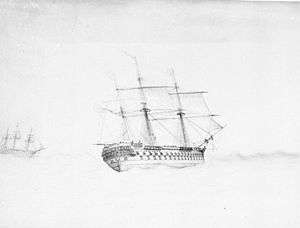HMS Albion (1763)
 | |
| History | |
|---|---|
| Name: | HMS Albion |
| Ordered: | 1 December 1759 |
| Builder: | Deptford Dockyard |
| Launched: | 16 May 1763 |
| Honours and awards: |
|
| Fate: | Wrecked, April 1797 |
| General characteristics [1] | |
| Class and type: | Albion-class ship of the line |
| Tons burthen: | 1662 (bm) |
| Length: | 168 ft (51 m) (gundeck) |
| Depth of hold: | 18 ft 10 in (5.74 m) |
| Propulsion: | Sails |
| Sail plan: | Full rigged ship |
| Armament: | |
HMS Albion was a 74-gun third-rate ship of the line of the Royal Navy. She was launched on 16 May 1763 at Deptford, being adapted from a design of the old 90-gun ship Neptune which had been built in 1730, and was the first ship to bear the name. She was the first of a series of ships built to the same lines, which became known as the Albion-class ship of the line.[1]
She saw her first action in the American War of Independence in July 1779 at the indecisive Battle of Grenada, when the British Fleet under the command of Vice Admiral Byron managed to avoid defeat from superior French forces.
Albion's next action was a year later on 17 April 1780, when British and French fleets met in the Battle of Martinique. A month later, on 15 May, the fleets met again and after a few days of manoeuvring the head of the British line confronted the rear-most French warships. Albion, leading the vanguard of the British fleet suffered heavy casualties, but with little to show for it. Just four days later the two fleets clashed for the third time but again it was indecisive with Albion heavily engaged as before, suffering numerous casualties in the process.
In 1794 Albion was consigned to the role of a 60-gun floating battery[1] armed with heavy carronades and moored on the Thames Estuary.
Fate
In April 1797, while heading to a new position in the Swin Channel, she ran aground due to pilot error. Two days later, during salvage efforts, her back broke, and she was completely wrecked. A court martial blamed the pilots, William Springfield and Joseph Wright, for imprudent maneuvering and going too far back before altering course. The court ordered that they lose all pay due them and that they never serve as pilots again.[2]
Citations and references
- Citations
- References
- Hepper, David J. (1994). British Warship Losses in the Age of Sail, 1650-1859. Rotherfield: Jean Boudriot. ISBN 0-948864-30-3.
- Lavery, Brian (2003) The Ship of the Line - Volume 1: The development of the battlefleet 1650-1850. Conway Maritime Press. ISBN 0-85177-252-8.